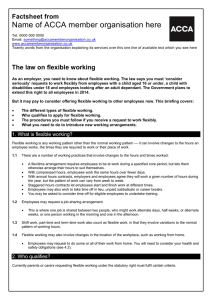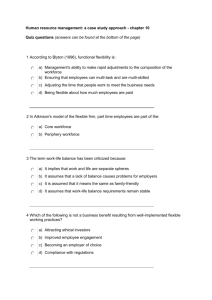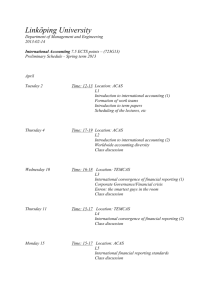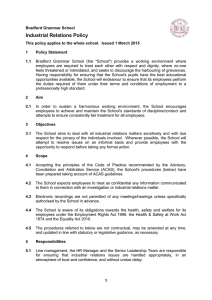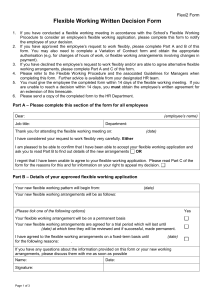The law on flexible working
advertisement
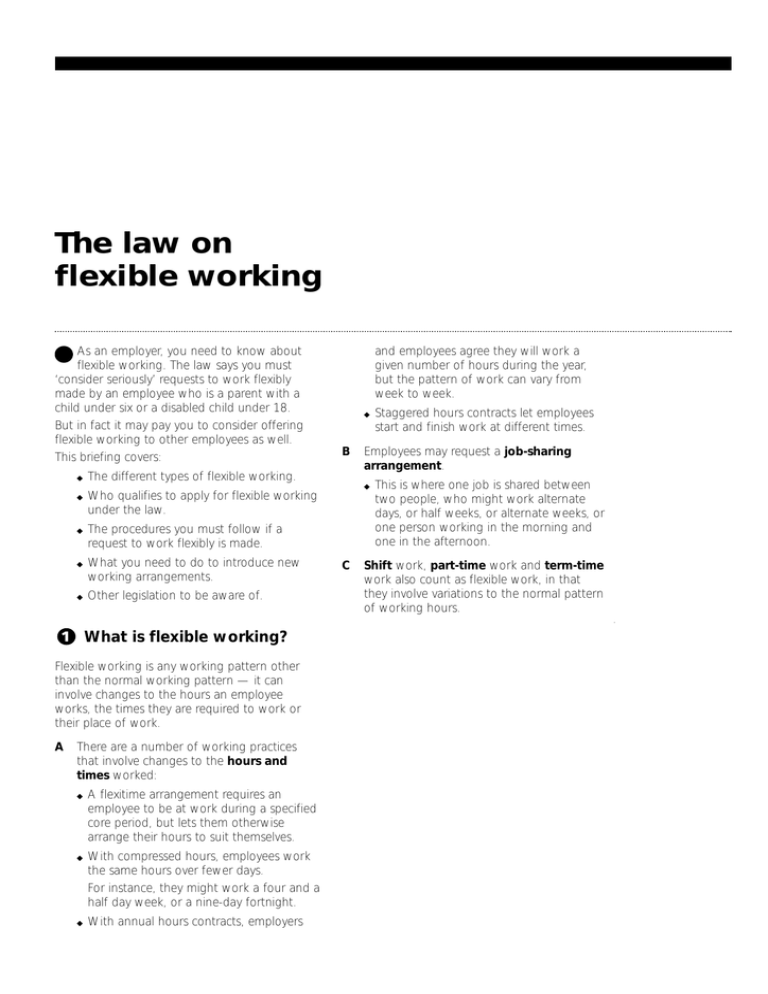
The law on flexible working As an employer, you need to know about flexible working. The law says you must ‘consider seriously’ requests to work flexibly made by an employee who is a parent with a child under six or a disabled child under 18. But in fact it may pay you to consider offering flexible working to other employees as well. This briefing covers: ◆ The different types of flexible working. ◆ Who qualifies to apply for flexible working under the law. ◆ The procedures you must follow if a request to work flexibly is made. ◆ What you need to do to introduce new working arrangements. ◆ Other legislation to be aware of. and employees agree they will work a given number of hours during the year, but the pattern of work can vary from week to week. ◆ B Employees may request a job-sharing arrangement. ◆ What is flexible working? Flexible working is any working pattern other than the normal working pattern — it can involve changes to the hours an employee works, the times they are required to work or their place of work. A There are a number of working practices that involve changes to the hours and times worked: ◆ A flexitime arrangement requires an employee to be at work during a specified core period, but lets them otherwise arrange their hours to suit themselves. ◆ With compressed hours, employees work the same hours over fewer days. For instance, they might work a four and a half day week, or a nine-day fortnight. ◆ With annual hours contracts, employers C Staggered hours contracts let employees start and finish work at different times. This is where one job is shared between two people, who might work alternate days, or half weeks, or alternate weeks, or one person working in the morning and one in the afternoon. Shift work, part-time work and term-time work also count as flexible work, in that they involve variations to the normal pattern of working hours. D Flexible working may also involve changes in the location of the workplace, such as working from home. ◆ Employees may request to do some or all of their work from home. You can agree that it should only be a temporary or transitional change. B The employee’s child must be under six or under 18, in the case of a disabled child. ◆ You will need to consider your health and safety obligations (see 4C). Who qualifies? To make a request for flexible working under the statutory right employees must fulfil certain criteria. A The employee must: ◆ Be the mother, father, adopter, guardian or foster parent of the child in question, or their husband, wife or partner. ◆ Have responsibility, or expect to have responsibility, for bringing up the child. ◆ Make the application as a means of enabling them to care for the child. ◆ Have worked for you continuously for at least 26 weeks before making the application. ◆ Have made no other application in the preceding 12 months. ◆ Be willing to agree a change in their working pattern, with a corresponding drop in pay if necessary (for example, if they want to move from full-time to parttime work). Implementation procedure Under the law on flexible working, both sides are required to follow the correct procedure. A It is up to the employee to prepare a detailed application well in advance of when they want to change their working pattern. B Business benefits Although you only have a legal obligation to provide flexible working arrangements in specific circumstances, you may want to consider introducing it for other employees. Flexible working can have a number of business benefits. ◆ The application must be in writing. ◆ The employee should be able to come up with a clear plan of how the new pattern would work and must show that the changes will not harm your business. Once you have received an application to work flexibly from an employee you must: ◆ Arrange a meeting with the employee within 28 days of receiving it. This is to decide a start date (if you agree), or to consider alternatives (if you do not). The employee has the right to be accompanied at the meeting by a companion. The companion must be a worker also employed by you. ◆ If you agree, write to the employee within 14 days of the meeting detailing the new working pattern and confirming the start date. ◆ If you do not agree, you must write to give clear business reasons (see C) why the proposed arrangement will not work in this case. You must date your refusal and set out your appeals procedure. A More flexible working patterns may attract employees to your company. ◆ Having a flexible approach will also help you retain existing staff. The application must be made no later than two weeks before the child’s sixth (or 18th) birthday. C You can refuse an application to work flexibly only if there is a clear business reason. B It can help to reduce employee turnover. Valid reasons as set out in the legislation are: C It may boost employee morale and commitment. ◆ The burden of additional costs. ◆ A detrimental effect on the ability to meet customer demand. ◆ An inability to reorganise work among other employees. ◆ An inability to recruit additional employees. ◆ A detrimental effect on quality. D The introduction of more flexible working arrangements has also been shown to reduce absenteeism. E It has also been proven that flexible working provisions can lead to noticeable improvements in employee productivity. page 2 ◆ A detrimental effect on performance. ◆ Insufficient work when the employee proposes to work. ◆ Planned structural changes. decide to make a formal complaint to an employment tribunal or to the Acas arbitration scheme. D If you refuse an application to work flexibly, the employee may appeal. E ◆ He or she must write to do so within 14 days of you sending your letter of refusal. ◆ You must have another meeting within 14 days of receiving this letter to hear the appeal. And you must write, accepting or refusing the appeal, within 14 days of this meeting. ◆ Try to deal with the problem internally at this stage. An informal discussion between you and the employee may clear up any misunderstandings. Or, if you have a formal grievance procedure in place, use this — it will be much quicker than involving external parties. If it is still not possible to resolve the dispute, the employee may decide to involve an external third party. This might be someone from Acas or some other mediator or conciliator. They will try to resolve the problem in an informal manner by mediating discussions between you and the employee. In some circumstances, the employee may Individual cases The requests you receive from individuals will often involve forms of flexible working tailored to their specific circumstances. For example: A A father may wish to work hours that allow him to drop off a child at school in the morning. B C The employee can only do this if you have failed to follow the correct procedures or if your decision was based on incorrect facts. ◆ If it is shown that you have not followed the correct procedure, you will have to reconsider the application. ◆ You may also have to pay compensation to the employee. The amount payable will be decided by the employment tribunal or the Acas arbitrator and will be limited to a maximum of eight weeks’ pay. Each week’s pay itself is currently limited to £270. If you still refuse the application, and the employee feels that their application has not been considered seriously, they may want to take further steps. ◆ F ◆ The mother of a disabled 14-year-old may need some sort of flexitime arrangement to allow for absences of a carer or to take the child to special classes. The mother of a young baby may need the flexibility to work from home at short notice. Individual requests for flexible working don’t necessarily entail a reduction in the total hours worked. Moving into flexible working Once you have accepted a request for flexible working you may need to put some changes in place. A You will need to amend the employee’s contract of employment to reflect the changes. ◆ You may want to agree a trial period to ensure the changes are working. See Employment contracts, HR 4. B If the new flexible working arrangement involves changes to the number of hours worked, you will need to amend the employee’s pay and holiday entitlement. C If the employee will be working from home, health and safety requirements will apply just as they do to those who work in the office. An initial risk assessment must be carried out although this can be done by the employee. Areas to consider are: ◆ The seating and layout of the employee’s computer workstation. ◆ Electrical equipment. Has it been tested and certified? ◆ Extension leads for telephones, PCs and printers. Make sure there are no trailing leads. ◆ Adequate lighting levels, ventilation and room temperature. You will need to give employees simple, specific health and safety advice and record what has been done. See Health and safety, LA 3. D Consider the impact of the changes on page 3 other employees. ◆ E entitled to be treated ‘no less favourably’ than their permanent, full-time colleagues. If an employee will be working fewer hours than previously, make sure you have adequate cover in place. Other employees may become resentful if their workload increases because of the changes. ◆ You should inform other employees as early as possible. ◆ You also need to make sure work is allocated fairly. For example, in a job share you need to make sure that both parties have equal responsibilities. Make sure you are consistent in your approach to flexible working. ◆ Keep clear records of who has applied to work flexibly, and what your response was. ◆ Monitor and evaluate how the new arrangements are working so you can put changes in place if necessary. Other legislation ◆ See Discrimination, HR 24. D People who work on annual hours or termtime contracts are protected by the working time and minimum wage regulations, just like full-time employees. See Working time and the minimum wage, HR 25. Further help A The Department of Trade and Industry website has a good basic summary of the flexible working legislation at www.dti.gov.uk/er/flexible.htm. ◆ Generally speaking, the same legislation applies to employers offering flexible working patterns as to those adopting more conventional arrangements. You should also take account of some specific forms of protection for employees working flexibly. A The employee is protected against dismissal or constructive dismissal under the flexible working rights. B It is unlawful to dismiss an employee because: ◆ They have applied to work flexibly and it has been granted. ◆ They have made or intend to make a complaint to an employment tribunal. ◆ C If you are making employees redundant, make sure this has nothing to do with their right to work flexibly. ◆ You can find more detailed guidance in ‘Flexible working — the right to request and the duty to consider: a guide for employers and employees’. Go to www.dti.gov.uk/er/flexible.htm. Scroll down and click on the title to download the guide or call the publications orderline on 0870 1502 500 to request a copy. Acas has a good guide to forms of flexible working, plus an advice leaflet and various forms on its website at www.acas.org.uk. You can also call the helpline for further advice on 0845 747 4747. Visit www.tiger.gov.uk for an interactive guide to flexible working rights. ◆ B If you place a requirement on an employee to work full time, the employee may be able to make a claim against you for indirect discrimination or indirect marital discrimination under the Sex Discrimination Act. There is no ceiling on the amount of compensation that can be awarded in such cases. It will take you through your duties as an employer in a series of steps tailored to your specific circumstances. Employees are protected from dismissal on these grounds. See Redundancy, HR 20. C When implementing flexible working arrangements you will need to make sure you are not discriminating against the employees concerned. ◆ Under the part-time workers regulations, fixed term and part-time employees are page 4
